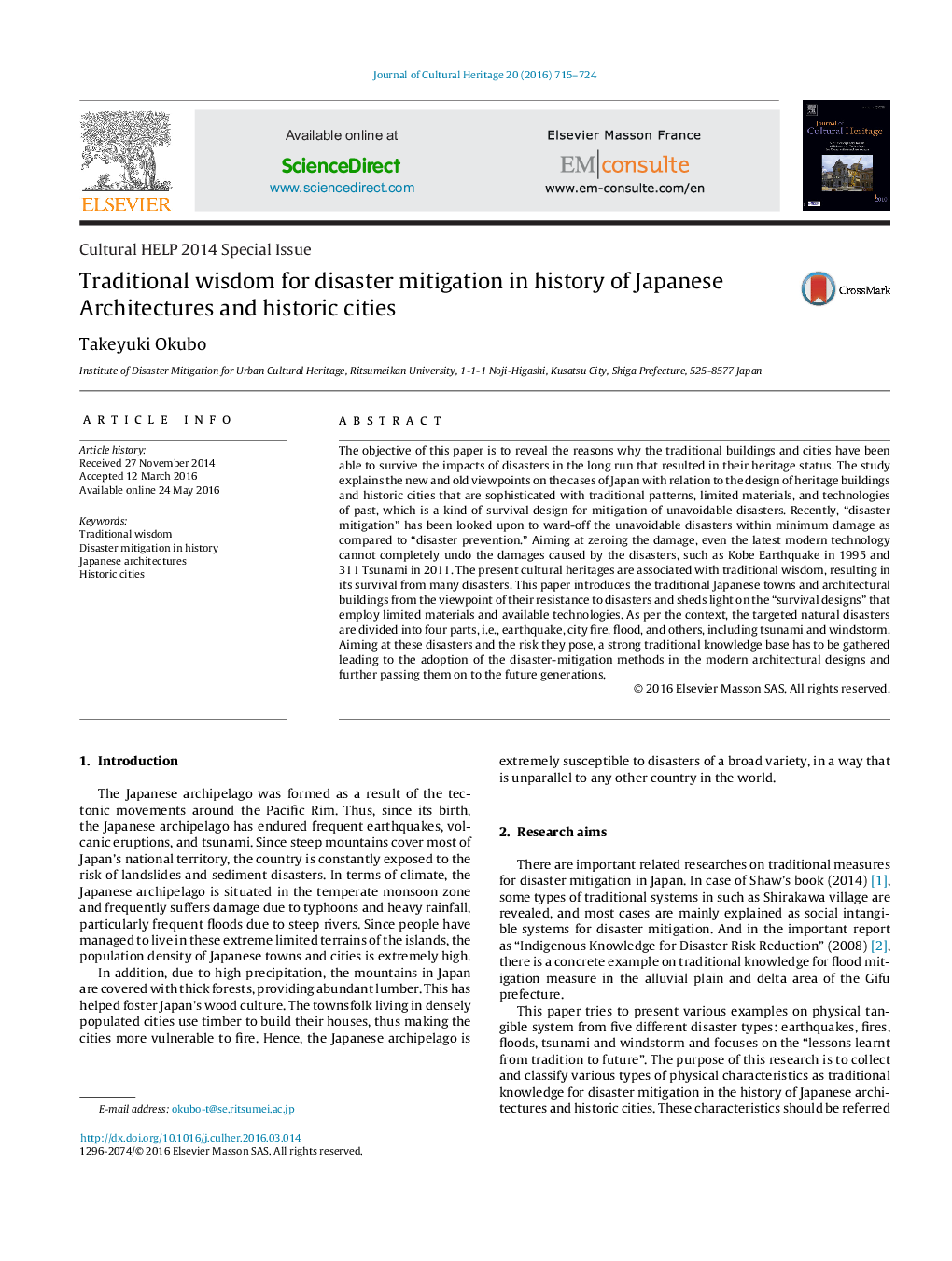| کد مقاله | کد نشریه | سال انتشار | مقاله انگلیسی | نسخه تمام متن |
|---|---|---|---|---|
| 1037829 | 1483956 | 2016 | 10 صفحه PDF | دانلود رایگان |
عنوان انگلیسی مقاله ISI
Traditional wisdom for disaster mitigation in history of Japanese Architectures and historic cities
ترجمه فارسی عنوان
عقل سنتی برای کاهش بلایای طبیعی در تاریخ معماری ژاپن و شهرهای تاریخی
دانلود مقاله + سفارش ترجمه
دانلود مقاله ISI انگلیسی
رایگان برای ایرانیان
کلمات کلیدی
عقل سنتی، کاهش آسیب در تاریخ، معماری ژاپنی، شهرهای تاریخی،
ترجمه چکیده
هدف این مقاله نشان دادن دلایل اینکه ساختمان های سنتی و شهرها در بلندمدت قادر به اثرگذاری وقوع بلایای طبیعی بوده و منجر به وضعیت میراث آنها شده است. در این مطالعه، دیدگاه های جدید و قدیمی در مورد ژاپن با توجه به طراحی ساختمان های میراث و شهر های تاریخی که پیچیده با الگوهای سنتی، مواد محدود و فن آوری های گذشته، است که نوعی طراحی بقا برای کاهش اجتناب ناپذیر بلایای طبیعی به تازگی، یک فاجعه کاهش یافته است به منظور جلوگیری از حوادث غیر قابل اجتناب در حداقل آسیب نسبت به پیشگیری از حوادث، مورد توجه قرار گرفته است. با هدف کاهش تلفات، حتی از آخرین تکنولوژی مدرن نمی تواند به طور کامل آسیب های ناشی از بلایای طبیعی مانند زمین لرزه کوب در سال 1995 و 311 سونامی در سال 2011 را خنثی کند. میراث فرهنگی در حال حاضر با عقل سنتی همراه است، و بقای آن از بسیاری از بلایای طبیعی . این مقاله شهر های سنتی ژاپنی و ساختمان های معماری را از لحاظ مقاومت خود در برابر بلایای طبیعی نشان می دهد و نور را در طراحی طراحی بقا معرفی می کند. که مواد محدود و تکنولوژی های موجود را استخدام می کنند. همانطور که در متن آمده است، بلایای طبیعی هدفمند به چهار بخش تقسیم می شوند: زمین لرزه، آتش سوزی، سیل و دیگران، از جمله سونامی و سیل آسا. با توجه به این بلایا و خطر آنها، بایستی یک پایگاه دانش قوی سنتی جمع آوری شود که منجر به پذیرش روش های کاهش آسیب پذیری در طرح های مدرن معماری و انتقال آنها به نسل های آینده می شود.
موضوعات مرتبط
مهندسی و علوم پایه
شیمی
شیمی تئوریک و عملی
چکیده انگلیسی
The objective of this paper is to reveal the reasons why the traditional buildings and cities have been able to survive the impacts of disasters in the long run that resulted in their heritage status. The study explains the new and old viewpoints on the cases of Japan with relation to the design of heritage buildings and historic cities that are sophisticated with traditional patterns, limited materials, and technologies of past, which is a kind of survival design for mitigation of unavoidable disasters. Recently, “disaster mitigation” has been looked upon to ward-off the unavoidable disasters within minimum damage as compared to “disaster prevention.” Aiming at zeroing the damage, even the latest modern technology cannot completely undo the damages caused by the disasters, such as Kobe Earthquake in 1995 and 311 Tsunami in 2011. The present cultural heritages are associated with traditional wisdom, resulting in its survival from many disasters. This paper introduces the traditional Japanese towns and architectural buildings from the viewpoint of their resistance to disasters and sheds light on the “survival designs” that employ limited materials and available technologies. As per the context, the targeted natural disasters are divided into four parts, i.e., earthquake, city fire, flood, and others, including tsunami and windstorm. Aiming at these disasters and the risk they pose, a strong traditional knowledge base has to be gathered leading to the adoption of the disaster-mitigation methods in the modern architectural designs and further passing them on to the future generations.
ناشر
Database: Elsevier - ScienceDirect (ساینس دایرکت)
Journal: Journal of Cultural Heritage - Volume 20, JulyâAugust 2016, Pages 715-724
Journal: Journal of Cultural Heritage - Volume 20, JulyâAugust 2016, Pages 715-724
نویسندگان
Takeyuki Okubo,
